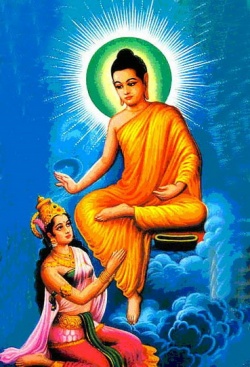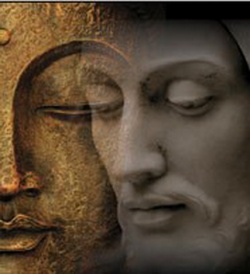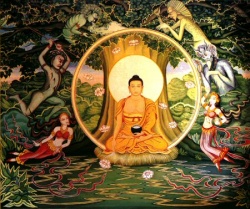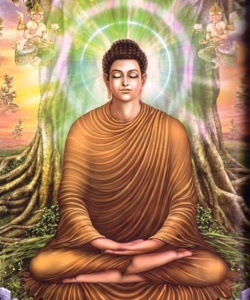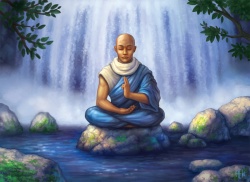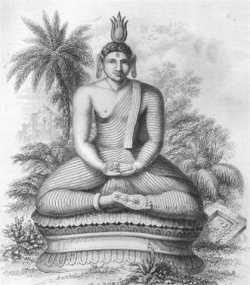Why is Traditional Buddhism Better Than the Modernized One?
Nowadays most young American students of Buddhism seem to favor a modernized form of Buddhism. Even a very well known Guru with many students emphasizes the modernization of the Buddha's Dharma, so this talk is needed to explain why I am so foolish and backward as to emphasize traditional Buddhism. It will make clear to you what my view is.
1. The Truth: First of all, surely our religion is aimed at the Truth. Science also has its truth and every religion has its own idea of truth. Truth can be defined as what was, is, and will be. It must be constant. If it is changeable it is not the real truth.
Truth is beyond time. Buddha is called Du Sum Chenpo which means the knower of three periods. He has already seen all three times including the future. Du Sum Chenpo is the proper name of the first Karmapa, but also a common name applicable to all Buddhas. A Buddha must know not only the present, but also the past and future as well. Who can be more advanced than a Buddha?
If Buddhism is true it must be applicable even to the future. We cannot say that the Buddha's teaching was only for his contemporary era three thousand years ago and that since then many things have changed and that therefore we must modernize his teachings. The modernized teaching of today will become the traditional teaching of tomorrow. The day after tomorrow somebody may modernize your teaching! The latest scientific knowledge always overthrows the former scientific knowledge. Therefore, science is not reliable. Nowadays we are beginning to see the many problems such as pollution caused by science. The new science always seems better than the old one. This is quite easy to understand. This is because science only gives changeable knowledge, but not the real truth, the real religious truth.
For example, when I was young I heard that to cure venereal disease one had to use an injection of the drug called 606 or the one called 914. These numbers were derived from the number of experiments done to find these drugs. Still could even this many experiments cover and cure all of mankind? And now we use Penicillin instead of them. But some people cannot tolerate Penicillin and some strains of venereal disease have become resistant to it. So now we will have to search for even newer drugs.
All scientific knowledge is produced by the human brain. It is therefore only temporary limited knowledge. So it has only temporary utility and can be only temporarily fruitful. But the eternal truth of religion remains unknown to the scientists. To understand the truth one must emphasize that the traditional teaching is better than the modernized one.
If the Buddha's teaching needs to be modernized, after a few years it will become the traditional teaching and have to be modernized again. So it cannot be the real truth. By definition the truth must be what was, is, and will be. It must always be the same.
2. Time: When we talk about truth we must deal with time and space. Even according to Albert Einstein's authoritative Theory of Relativity, time has no limitation. What we call time has no ultimate reality. Someone moving relative to us would have to use a different time to explain the same events. But there is still the limitation of space (or of four dimensional interval), but in Buddhism it is always said that time has no limitation and that space has also no limitation. Since time has no limitation, Buddhism is beyond time.
What does it mean to say old or new? Every day is new. Every day is also the same. This is the truth. In ancient times everything was void. In the present everything is void. In the future everything will still be void. Every person is without ego. Every dharma is without ego. This does not mean that in the Buddha's lifetime life was so simple, so he could say that everything is sunyata, but that now in our modern times everything has become so complex that it is impossible to meditate on the sunyata. Some say there are so many things to distract us, not like in the Buddha's time when everything was simple and primitive. Maybe Buddha could meditate on the non-ego of Dharma, but how can we be expected to meditate on sunyata? We must have sex, we must have wine, we must have food, we must have fun, we must have T.V., then we can enjoy ourselves. What is the use of meditating on the void?
This is all mistaken. This kind of thinking is within the limitation of time. Beyond time the Truth is always happening, is always new, is always advanced. The truth has always attained to the very end. Rather, it has attained to the very non-end.
3. Space: Space also has no limitation. People always used to say that Heaven is one thing, Earth is another. But now the Astronauts have landed on the moon. The Buddhist Sutras show us a space much wider than the space perceived by science. The stars that can be listed in an astronomy book occupy a very small space compared to the space of Buddhism. If you claim to be more advanced than Buddhism you must point out some worlds that do not appear in Buddhism. Are you modernized enough to do that? But Buddha talked about many worlds never heard of by science, worlds that will not be found on any human map. Who is the advanced one? Who is the modernized one? The one who seems to be advanced is really just a fool because he lacks knowledge of Buddhism.
4. Speed: It seemed that the speed of sound was the ultimate speed. When airplanes tried to go faster they would disintegrate and so people talked about the "sound barrier". Now that speed has been exceeded but the scientists seem to think that the velocity of light is the ultimate speed. Nothing can travel faster than light. But our Buddhism emphasizes the speed of the mind. This has nothing to do with the one thousand foot per second speed of neural processes. No kind of material velocity can compare with it.
Everyone knows the story of the competition between Milarepa and the outsider. They were to race to the top of the mountain. It seemed obvious that the outsider started out riding his magic drum, flying up the mountain. Milarepa was still asleep. All his disciples were saying, "Get up, get up. Don't be so lazy, get up, get up. Otherwise you will not win." Milarepa said, "Never mind. Let him go!" Then when the outsider was almost to the peak of the Himalayan mountain, just by the power of his mind, Milarepa arrived instantly at the top and won. This is known as reaching the goal without walking.
Who could go faster even with an airplane? Who is the advanced one? Your modernized speed is at the most a result of clever use of fire and air. Fire and air cannot compare with Milarepa's mind.
5. Position (High and Low): Nowadays everyone in America always says "Hi!". On Shattuck Avenue, there was a carpenter taking a roof off a building. He called to me, "Hi!". I said, "I'm not high. You are the one who is high, I am just low. But I am much safer than you. You must take care of your high!" What does high really mean? The real high must be like the tuft on the Buddha's head. Compared to the head of a man, a God's is much higher. But no God can see the top as the tuft on the Buddha's head. This is the real high. But this kind of high is with the feet touching the ground. Buddha can even touch Hell with his feet. This is the real kind of high. You should base your high on a good foundation at the bottom, then you can really touch the high. The traditional high is like this. The magical high is like this. The supernatural high is like this. Even though men landed on the moon this is not the real high. Who is the advanced one?
6. History: According to history the Hinayana progressed to the Mahayana, then the Mahayana advanced to the Vajrayana. So, following history, we should change the Vajrayana into the Modern-yana? The Modern-yana is just sex, wine, and T.V. Is it much better than Vajrayana? Is this true? If not, one might ask why has the Hinayana changed into the Mahayana and the Mahayana into the Vajrayana? But we must understand that this is not really a change, rather it is a gradual education. Even though the Hinayana was taught for a certain period during the Buddha's personal time, and then later the Mahayana was taught, still the Mahayana is always based on the Hinayana and includes it. The Mahayana never teaches that one should reject the Hinayana. It is based on the Hinayana and then develops a more complete teaching. The traditional teaching is still there. Could there be a Bodhisattva without renunciation? Should a Bodhisattva not think about Impermanence as taught by Hinayana? All of the Mahayana and Vajrayana are based on the Hinayana. Why was Milarepa so advanced in the Vajrayana? Because his Hinayana foundation was so well confirmed. His sufferings were an example not of the Vajrayana but of the Hinayana. We know that Milarepa was a Patriarch of the Vajrayana. But who has suffered like him? He lived in a cave, ate only nettles, and suffered from cold. Without this Hinayana foundation how could he have succeeded in the Vajrayana? So the more you emphasize the traditional teaching, the more you succeed. This is why Milarepa said, "From the lowest state I can get the highest position. From practice singly by myself many dakinis will come to me. From a very patient practice I will quickly come to the very highest goal of Mahamudra." Thus he emphasized three secret instructions. From low to high, from single to double, and from slow to quick. From this we learn that if you really want to advance in the spiritual stages, you have to emphasize the traditional teaching.
7. Finished and Unfinished Teachings: Our Buddha always said that Buddhism has both finished and unfinished teachings. Unfinished means the Hinayana and Mahayana. Finished means the Vajrayana. When something is finished it is complete. If it is complete it is not changeable. He who wants to change the Buddha Dharma is quite a sinner. He cannot lead anybody to get the attainment. He just cheats his students and takes their money. That's not right!
8. The Propagation of Buddhism: Surely many things are very difficult to accept in this Kali Age. In ancient times people were able to accept the Hinayana very easily. But now if you try to teach Hinayana it is very difficult to have it accepted. This is quite true and I myself must admit it. But the propagation of Buddhism is not just a form of advertising. In the advertising business, the more you cheat, the more money you get. But when propagating Buddhism, even if they do not accept it you must not abandon or pervert the real Dharma. You must still teach it according to the tradition.
Suppose there was a person who was really a Bodhisattva or Vajrasattva, born on earth for his final lifetime. The teaching must be preserved here for him. If everyone follows the modernized thinking and nobody emphasizes the Tradition, how can this being meet it?
9. The Goal: Everybody has some aim or goal. Is the proper goal one that is favored by modernization or by the traditional teaching? Surely the goal has been experienced directly and taught by Buddha in the Buddha Age. Buddha also knew everything that was to happen in the future. Can those modern teacher's wisdom compare with his? If not, which one should we follow?
Buddhists should follow the Buddha himself. Buddha is the Guru of the traditional teaching. Through the generations he has imparted it to us. If we do not follow the traditional teaching, Buddha's efforts have been wasted.
10. The Three Ages: Buddha always emphasized the three ages. The first was called the Buddha Age. It lasted for five hundred years. Buddha preached for forty-nine years. At the age of eighty he left us, but his teaching is still here. If you neglect to follow the tradition, how can you expect to become a Buddha yourself?
But when I advised Mr. Douglas to buy A Buddhist Bible he said that he did not have any money. He had five hundred dollars to put into training in psychology, but not five dollars to buy that book. If you do not follow the teaching, how can you become a Buddha? If you cannot become Buddha himself, what is your aim in studying Buddhism?
The second age is called the Image Age. In the Image Age at least the image of Buddha still survives. From the image we can see the Buddha. But today where can you even see such an image?
The Image only survives because of the Tradition. Today the yellow Robe, tomorrow the Yellow Robe, the day after still the Yellow Robe.
Once I read a message published by a certain American Buddhist Center in Massachusetts. The leader of the center is a laywoman. Yet she dared to write such a message which said, "Why do those monks come here in their yellow robes? What is so powerful about a yellow robe? They could wear any kind of a robe. And why do they have to shave their heads? Why don't they have long hair like the hippies? Those monks don't even wear leather shoes. Their bare feet are very dirty. Why should they follow such a tradition? It is useless. If you want to promote Buddhism in America you have to do everything like the Americans."
I wrote a letter of criticism telling her she was quite wrong. So we see that in this modern time even the Image is very difficult to preserve. Everything must be more and more modernized. There is no certainty in modern dress. The fashion changes continually. Now some people have begun to wear Japanese and Tibetan clothing. Not like the monks but just like the common laymen's. Is the tradition of Buddhism the same as the tradition of Tibetan laymen's dress? If not, why do they use it? Actually this kind of modernization is nonsense. And now each Center wants to have its own uniform. Here a pocket, there a pocket. Does this modernization help Buddhist teaching?
But when we maintain the Image we worship Him. We know that the yellow robe exemplifies the Buddha. A certain color and a certain form help the student have a certain faith. It is not being changed all the time. So even in the Image Age one should still follow the Tradition. The modernization of outward things like dress is always changing. Sometimes the modern fashion favors traditional things, other times not. Therefore it is not reliable.
The Kali Age is the time when the Dharma declines more and more in order to fit people's modernization. Has it started already? Yes! The Buddha Age lasted for five hundred years. The Image Age lasted from the five hundred and first year after Buddha's birth until the fifteen-hundredth. According to the Chinese Buddhist records it is now more than three thousand years since the Buddha was born here. So the Kali Age has already started by more than fifteen hundred years.
Why do people nowadays favor modernization so much? It is only because of their habits. The Kali Age is a time when the people have become the slaves of their habits. The Buddha's personal teaching has been forgotten and even his image is very difficult to see.
Even the monks themselves do not keep the Tradition. Recently a Chinese monk came to see me. The first time he came dressed as a layman. I did not pay any special respect to him. The next time he wore a robe. I said, "Oh, today you have put on a robe. This is quite right because you are a monk and we should worship you. When I see the Robe it is just like seeing the Buddha. It is very rare." "But," I said, "You still don't follow the Hinayana rule completely. Why do you still wear white clothing inside? Why do you still use leather shoes? If you can change both, then I will worship you." He was very ashamed and went away.
Thus we see that even the monks cannot follow the Tradition. Much the less it is followed by ones who come from the Universities, by the modern students who have more or less Hippie habits. So they only run after wine, free sex and laziness. So human nature becomes stronger and the Traditional teaching becomes weaker. The attempts to modernize the teachings of Buddha are very representative of the Kali Age habits. If you continue to emphasize the modernized teaching, the bad habits will increase and it will be the end of the Dharma.
I am very sorry to say that to emphasize the Traditional teaching is like climbing up a mountain. Surely it is very difficult, but to emphasize the modernization is just like falling off a cliff. It is very easy. So now we see even a monk may have an accident. If one has accidents even in this lifetime, what will happen to him after he dies? What state will he fall into? Will he even be able to maintain this human condition for another lifetime? How can such a person be a monk? Should he be praised as a good monk?
But the man who follows the tradition is usually treated as a fool. It is just like when Milarepa's sister and fiancee came to visit him at his cave. They said, "On the way here we saw those famous lamas walking in procession through the street. They have so many houses, so many attendants, so much beautiful property. But look at you! You live in this cave. You are so poor you don't even have trousers. And when we do give you cloth for trousers what do you do? You cut it up into little pieces and make coverings for your fingers and toes. What a foolish man you are!"
Nowadays where can we find such a one as Milarepa? But of people like his sister and fiancee there are very many. They just advise you, "Why don't you do like this monk and that monk? You would get a lot of money. Why should you live alone here like you do?" Should I take their advice? I'm just feeling ashamed for not being able to be like Milarepa completely.
11. Majority or Minority? It is a very common mistake to think that the majority is always better than the minority. But the real Buddhist always emphasizes Wisdom, Samadhi, and Realization. He does not care about money, comfortable conditions or whether he has students or not. It is not important to have a large membership, the purpose of Buddhism is not for fighting. For fighting, it is useful sometimes to have a large membership. As Mao Tse Tung said, "I have 700,000,000 people. Even if you killed half of them I would still have enough left over to kill all the Americans! " For fighting maybe the majority always has the advantage. But for Samadhi and for the Great Compassion, few is better.
To teach the Dharma is not the same as opening a theater. Just sell a lot of tickets and get a lot of visitors, then say, "Look! Our teacher is so famous. We can teach you how to fight; we can teach you how to love." In this way you can attract a majority, but what is the use of this kind of majority?
Are not the ants more numerous than men? Are the ants more valuable than men? Are there not more students than professors? Are the students therefore wiser than the professors? The majority may select a president, but is the president a majority himself?
Most men throughout all of history actually are fools. Important is just the wise leader leading the majority but not vice versa. Whenever and whosoever was a kind leader, his generation was peaceful; if he was cruel, that generation suffered. It is just like Mao who makes every Chinese suffer in equal poverty and equal slavery. The respect for the majority is a modernization which should not be emphasized.
Always the minority is the wise one; the minority is the powerful one. He may also be the sinful one, but nevertheless the minority is always the important one. In history we can find many great personalities. Does history belong to the people, to the multitude? Certainly not! In the history of every country, at every time, it is always the very few who are wise enough, compassionate enough--or powerful enough, or cruel enough--in any case it is always the minority but not the majority that determines the course of history. So do not think that where you find a lot of people is the place to find good Buddhism. If you think like this you will fall.
12. Salvation: Many say that if you want to save people you must have many students. If you do not have a lot of students how can you save them? But what kind of students? If they are only students of sex, wine, and fighting, maybe it would be better if there were no such centers at all. They are no different from the rest of society, no different from Hell, no different from common life.
They may be even worse. Consider what happens in such communities. Many young people are brought together. Some are males; some are females. So they love each other. Nobody controls them. There are no parents around to control them. There are no teachers or professors to control them. So they just exchange bad habits with one another. If they were living at home, they would only have one set of bad habits. If they live in a community, each also acquires the bad habits of all the others.
The question is, are you really saving anybody? If you are really saving people, the more the better. If you are harming them, the fewer the better.
If a doctor is able to save the patients, then the more people that go to him the better it is, but, if he is just a quack who takes their money and leaves them to die, they would be better off without him. Then they might be able to find a real doctor and be cured.
What does salvation really mean and who can do it? One must distinguish between temporary good deeds and eternal good deeds. A person practicing Mahayana can do many good deeds to help others, such as giving money, giving medicine, giving books or healing diseases. But are these good deeds of any lasting value?
For example, consider the Y.M.C.A. It provides a convenient place to play. There is a swimming pool, boys and girls may meet and love there. There are many convenient things there to enjoy. Such a place seems very nice, but if Jesus, the traditional Jesus, were alive, He would drive all such persons away. How do I know? From the Bible.
When He came to Jerusalem, He saw many businessmen in the Temple. He drove them away. Are not such buyers and sellers the majority? There were many, many like them. But in the whole country there were only twelve real followers. Even among those twelve, there was one disciple who sold his Master Jesus.
I do wish that the Gurus of Buddhism would not be sold by their disciples. But now I hear that some students even fight with their Guru. Actually if such people do not practice the traditional teaching but just gather together, pray together, have sex together, and drink together, what is the use? It would be better if there were no such organization. To find the real salvation one must follow the Tradition.
A good example of the traditional teaching may be found in the biography of Milarepa. When he had reached the point where he could actually fly through the air, he said to himself, "Now I must be a savior. I must go to where the people are and save them." But then he thought, "No, if I go there I will just become like them and follow their ways. I will learn their customs and habits but they won't learn anything from me. If I am really worthy to be a teacher the Buddha will send some students to me who are really Bodhisattvas, real incarnations, who will be useful, who will really accomplish something, who will be very faithful. They will be my students even if they are just ghosts and animals."
This is the Eternal Salvation. Milarepa saved many ghosts, many animals, and many real students with human bodies as well. Such students did not come to Milarepa just to follow their own habits.
Nowadays most students just think like this: "Oh, others like this teaching, therefore I also like it." Both like it; both are sinners. There is a story in a joke book: On Lincoln's Birthday, a father said to his son, "When Lincoln was your age, he could carry railroad ties." The son was very clever and replied, "Maybe so, but when Lincoln was your age, he was the President."
So nowadays it seems that the father and the son, the Guru and the student are the same. Neither do the gurus try to help the students to change their bad habits, nor do the students seek out the special teaching that would help them change themselves. This kind of salvation is worse than nothing. They would be better off with no salvation.
If we really want to save people, especially in the Vajrayana, we don't do any worldly things. We even refrain from giving money or from curing diseases. A real hermit will just utilize all of his time to practice from morning to night. Then when he sleeps he will practice Sleep Yoga. When he dreams he will practice Dream Yoga. When the bardo comes he will practice Bardo Yoga. Not even one moment of his time can be occupied by worldly things.
But if one goes and investigates the modern Buddhist communities and centers, he will find that they are full of worldly things. But such a center, full of worldly things, will eventually be flourishing.
Such temporary illusory salvation is the very thing that makes the real Eternal Salvation impossible. It is not real salvation. The more you emphasize modernization the further you go from real salvation.
How can anyone save others if he cannot even save himself? Why does such a modern Guru have accidents? Why do they talk about the Hinayana but just contact many girls and wives? To hear them talk you might think that they are better than Buddha Himself. But sometimes their acts are worse than their students .
I do wish that every Guru, Lama and monk was a real savior. I would like to worship them, take refuge from them and be saved. But we must find the real one. Now our real one has come. I do hope that we all get a chance to be blessed by Karmapa Rinpoche. Thank you.
